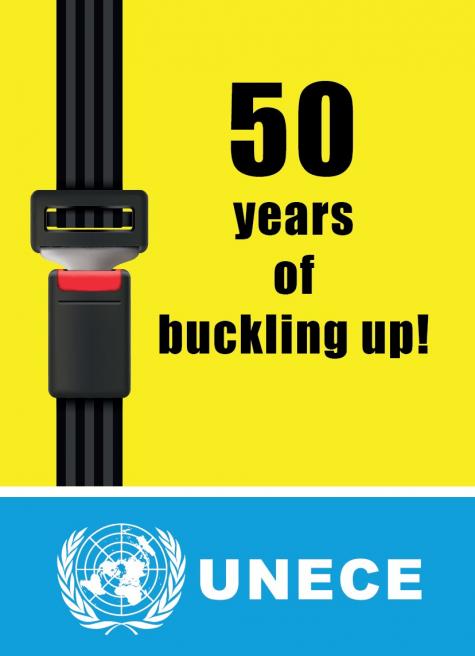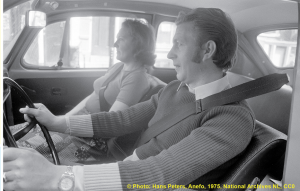The mandatory wearing of safety-belts in cars first introduced in Europe at the turn of the 1970s has saved millions of lives around the world in the past 50 years.
According to the World Health Organization, the use of safety-belts by occupants of vehicles in front seats reduces the risk of fatal injuries by 45 – 50 % and the risk of death and serious injuries among rear seat occupants by 25%.
Technical specifications of safety-belt use and installation stem from UN Regulation No. 16, which entered into force on 1 December 1970.
In the following years, a number of countries introduced legislation to make the use of safety-belts in vehicles compulsory, including:
France in 1973
- Spain in 1974
- the Netherlands, Norway and Sweden in 1975
- Germany in 1976
- Canada (Ontario) in 1976
- Portugal in 1978
- Switzerland in 1981
- United Kingdom in 1983
- Poland in 1983
- New York State in 1984
- Russian Federation in 1987
- Italy in 1988
- China in 1993
Decline in road fatalities in developed countries
Today, safety-belts remain the best vehicle safety device to protect passengers from being severely injured in a crash or being ejected from the vehicle.
Over the past several decades regulation and consumer demand have led to increasingly safe cars in higher income countries, in turn leading to fewer road fatalities. For example, in the UNECE region, total road fatalities decreased by 25% in between 2000 and 2010, and by 15% in the period 2010-2019. In particular, this drop was more significant among car occupants.

According to the ITF Road Safety Annual Report 2022, the period between 2010 and 2019 saw a marked drop in the number of car occupant road deaths in developed countries, especially in Greece (-63%), Norway (-54%) and Korea (-51%). An additional 13 countries (Switzerland, Spain, Argentina, Luxembourg, Ireland, Denmark, Portugal, Lithuania, Sweden, Australia, Belgium, and Slovenia) recorded reductions above 30%.
Accrued legislation and compliance needed in developing countries
However, too many countries around the world still need to enact appropriate legislation requiring drivers and passengers to wear safety-belts in front and rear seats, and to enforce stricter compliance.
Some 1.35 million people still die on the roads every year, 93% of them in developing countries. In addition, according to the latest WHO Global Status Report on Road Safety, only 105 countries have safety-belt laws aligned with best practice.
“The compulsory wearing of safety-belts, as well as helmets for two-wheelers, and increased political commitment to road safety, played a decisive role in the reduction of road deaths throughout Europe from the 1970s onwards”, reminds Jean Todt, UN Special Envoy for Road Safety. “We now must work with governments and all relevant industry stakeholders to ensure that people in the developing world enjoy the same level of safety as those in developed countries. That means adopting and enforcing safety-belt laws in line with international standards and providing access to vehicles, both new and used, with appropriately fitted safety-belts.”
Technical specifications of safety-belt use
UN Regulation No. 16, under the 1958 Agreement, is the only widely internationally recognized requirement for safety- belt use in vehicles. It defines the requirements an effective safety belt must comply with, as well as tests for their certification to keep safe all kinds of occupants: adults, elderly people, and children.
The safety-belt must carry the type approval mark on the buckle tongue. A type-approved safety -belt needs to display a capital E in a circle, followed by a number that represents the country whose certified authority granted its approval. This is followed by a series of numbers and letters representing specifics of the type approval, approval number and production serial number.
Safety-belts type approved according to UN Regulation No. 16 are tested under the most severe conditions to endure ageing and to function together with other safety systems (e.g. airbags, pretensioners and load limiters) as part of the complete vehicle crashworthiness.
Currently there are 52 contracting parties to the 1958 Agreement worldwide, including African and Asian countries, which apply the UN Regulation No. 16 as national law. Several other countries worldwide are also applying this regulation with certain changes.
Note to editors
UNECE has a long history of promoting road safety by leveraging relevant technical expertise through various working parties and groups, such as the Global Forum for Road Traffic Safety (WP.1) and the World Forum for the Harmonization of Vehicle Regulations (WP.29).
The World Forum for Harmonization of Vehicle Regulations is the primary global body responsible for the development of international motor vehicle safety standards and its regulations provide a legal framework for UN Member States to apply voluntarily.
UN regulations adopted by the World Forum to protect vehicle passengers and other road users cover, among others, the following items: Safety-belts; safety-belt anchorages; airbags; electronic stability control; pedestrian protection; and ISOFIX child restraint anchorage points.
Given its important role in promoting global road safety, UNECE also hosts the Secretariat of the Secretary-General’s Special Envoy for Road Safety, and the United Nations Road Safety Trust Fund, which was launched in 2018.
Read about UNECE road traffic safety work
Explore and download all UNECE road safety data
Follow the activities of the United Nations Special Envoy for Road Safety
See how the UN Road Safety Fund finances project to save lives in low- and middle-income countries


